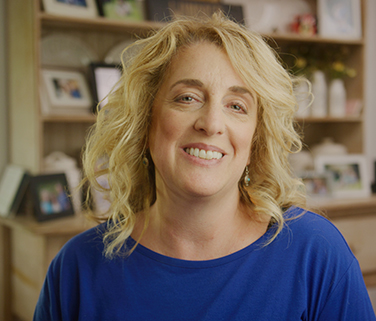Osteoporosis is not just an “old person’s disease.” Unfortunately, in the U.S., half of women over 50 will suffer a fracture due to osteoporosis.1
This was the case for Susan, who experienced early menopause, and at 47 years old, was forced to retire early after suffering from debilitating back pain. She was ultimately diagnosed with compression fractures caused by osteoporosis and became dependent on her daughter for help with daily tasks. Everything from emptying the dishwasher and doing laundry to picking up items from the floor could cause more pain or put her at risk for a fall. Osteoporosis drastically changed Susan’s life, but after speaking with her doctor she was able to find the right treatment to help improve her bone density.
Many women are unaware that bone loss begins at menopause and you don’t have to be in your 70s or 80s to get osteoporosis.2
Postmenopausal women should be aware of risk factors for osteoporosis such as a family history of hip fractures, low body weight, smoking, more than two drinks with alcohol per day and taking steroid medication.3 While weight-bearing and muscle-strengthening exercises are helpful for slowing bone loss and preventing falls, prescription medication is needed to reduce the risk of fractures due to osteoporosis.3
It is critical that women take the proper steps in preventing and treating osteoporosis. As Susan unfortunately learned, fractures can be life-altering events and cause chronic pain.4
Despite this being a significant women’s health issue and a major public health problem, many women are undiagnosed and untreated as the number of bone breaks due to osteoporosis continues to rise.5,6 Some fractures can be debilitating and require long-term care.4 Even after a break, fewer than 1 in 5 women are diagnosed, and about 80% of postmenopausal women are still not treated for osteoporosis.4
During World Osteoporosis Day, on October 20, and throughout the month, Amgen encourages all women over 50 to speak with their doctors to understand how they can help prevent fractures and manage this all-too-common condition. To learn more visit understandOP.com.
Watch the video below to hear more of Susan's story.
References
- National Osteoporosis Foundation. What is Osteoporosis and What Causes It? https://www.nof.org/patients/what-is-osteoporosis/. Accessed April 25, 2022.
- Endocrine Society. (2022, January 24). Menopause and Bone Loss. Endocrine Society. Retrieved October 6, 2022, from https://www.endocrine.org/patient-engagement/endocrine-library/menopause-and-bone-loss#:~:text=Menopause%20significantly%20speeds%20bone%20loss,are%20affected%20by%20osteoporosis%20worldwide.
- U.S. Department of Health and Human Services. (n.d.). Osteoporosis overview. National Institutes of Health. Retrieved October 6, 2022, from https://www.bones.nih.gov/health-info/bone/osteoporosis/overview.
- International Osteoporosis Foundation. Epidemiology Of Osteoporosis And Fragility Fractures [Fact Sheet]. https://www.osteoporosis.foundation/facts-statistics/epidemiology-of-osteoporosis-and-fragility-fractures.
- The World Health Organization. Bulletin of the World Health Organization. Exercise interventions: defusing the world’s osteoporosis time bomb. Available at: https://www.ncbi.nlm.nih.gov/pmc/articles/PMC2572346/. Accessed August 9, 2022.
- Reginster, J. Y., & Burlet, N. (2006). Osteoporosis: a still increasing prevalence. Bone, 38(2 Suppl 1), S4–S9. https://doi.org/10.1016/j.bone.2005.11.024.





